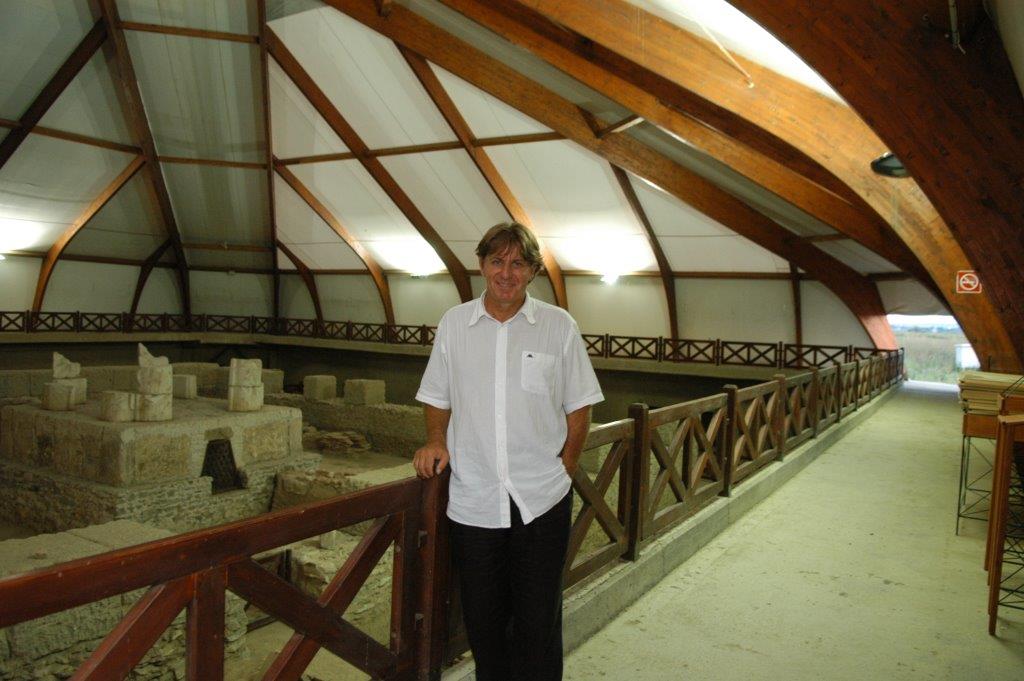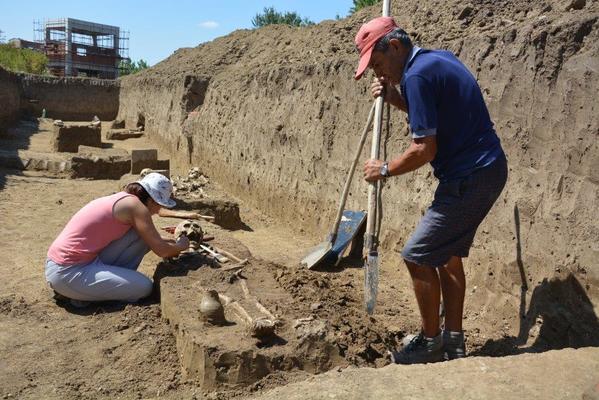
Archaeologist Miomir Korać (photo D. Janjić)
A few miles from Požarevac, in the archaeological site of Viminacium, an archaeologist known as the “Serbian Indiana Jones” has made some surprising discovers
Miomir Korać, director of the Archeological Institute SANU and chief archaeologist of the Viminacium project , is convinced that within 60 or 70 years this site will be one of the world's most important archaeological areas. Korać, known as the “Serbian Indiana Jones”, is even more enthusiastic after two tablets in gold and one in silver have been discovered in the tombs of the city, all of them bearing mysterious inscriptions.
On one of the tablets, the names of deities and demons recurrent in Assyria, Babylonia up to Egypt are written in Greek alphabet. Most unusual, the text was written vertically and not horizontally, a fact that scholars have not been able to explain. Sixteen different spirits are names on the tablets, including Ptah, Thobarabau and also Yahweh. Especially mysterious is the name Sesengenfaranges: the experts think it refers to an historical character and not to a demon, to the magician Sesen, son of Faranges.
"The mystery is why all these names are in a tomb in Viminacium. We think that they were written to protect the dead person from all known demons and the family member who wrote them obviously knew the mythology of the most important civilizations of their time," said Korać.
Another two tablets, one in gold and one in silver found in the tomb of a woman of 25 to 35 years old, were written exclusively in symbols. “It’s unlikely these symbols will ever be understood and this woman along side these tablets will remain a mystery. I think it should remain so,” adds Korać smiling.
Pagans and Christians
Korać is convinced that the latest discoveries have an enormous historical importance. They open the door to more detailed research into Roman society in the first centuries of the new era when the new Christian ideology was on the horizon and the old religions and ideologies were increasingly weakened. Not only are archaeologists and scientists interested, but also the general public. Videos published on Reuters site in a few days received more than 2.5 million hits.
In the ancient cemetery where the gold and silver tablets were found, pagan and Christian tombs side one another. All this has been hidden under the fertile soil of this part of Serbia for centuries waiting to be brought back to light.
“If they have been buried in a common cemetery then that means they lived together, along side each other. This is an extremely important discovery regarding the turbulent period coinciding with the first centuries of this era, and a strong incentive for further research. Viminacium will become even more important not only because of the good condition of the walls we keep discovering, but also because of the insights these findings offer into the Roman system and the life style of that period", believes Kovać.
Viminacium was the capital of the Roman region know as Moenia Superior. From what we have discovered, we believe that it had a population of about 40'000 inhabitants, which would make it the biggest city in the region. The Huns destroyed it in 443 and it was never rebuilt. Fortunately after the Huns' invasion no building was done on the site making it easier for the archaeologists research.
“All legion settlements are located under modern cities. Londinium is under London. Mediolanum is under Milan, Singidunum is under Belgrade. Viminacium is the only settlement placed under a moorland. In the last three or four decades we have found the remains of the well-preserved city and the entire "city of the dead” where 14,000 tombs were discovered.
Research continues and Viminacium hides a secret still to be revealed”, said Korać.
18 Roman emperors
The archaeologists at Viminacium are racing against time as the site is at the edges of the Drmno coal mine on which depends the functioning of the nearby Kostolac power plant. “First we excavate, then the diggers come to dig for coal. The mine respects this rule and it is very important that we have managed to protect 350 hectares of the Roman city and the legion settlement”, says Korać.
The city had an amphitheatre, an aqueduct, saunas and other services found in Roman cities of that period. During the years of the Huns destruction the ruins were abandoned to nature but also to local inhabitants who used the building materials. The Austro-Hungarian travel writer and ethnologist, Felix Kanitz, noted in the 19th century hundreds of bullock carts full of bricks being taken along the road from Viminacium to Požarevac to be sold in the local market.
Korać and his team have been researching Viminacium for more than three decades. Since the year 2000 this “Serbian Indiana Jones” has been in charge of the “Viminacium" project which has been declared an archaeological park. The Serbian press has described him as being fortunate as everywhere he puts his spade he finds something sensational. In one of the tombs, Korać and his team found the oldest monogram of Christ from the second decade of the fourth century.
Today, Viminacium appears on the UNESCO preliminary list. Korać is convinced it will attract the world's most important researchers and will naturally receive adequate international and local funding. The site is considered of great importance, particularly for understanding the life style and relations within the society of the Roman Empire. "On the other hand," concludes Korać, "18 Roman Emperors were born on Serbian soil."



































 To Top
To Top